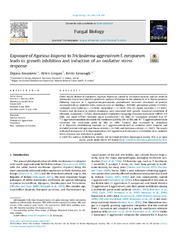Приказ основних података о документу
Exposure of Agaricus bisporus to Trichoderma aggressivum f. europaeum leads to growth inhibition and induction of an oxidative stress response
| dc.creator | Kosanović, Dejana | |
| dc.creator | Grogan, Helen | |
| dc.creator | Kavanagh, Kevin | |
| dc.date.accessioned | 2021-02-18T10:53:12Z | |
| dc.date.available | 2021-02-18T10:53:12Z | |
| dc.date.issued | 2020 | |
| dc.identifier.issn | 1878-6146 | |
| dc.identifier.uri | http://intor.torlakinstitut.com/handle/123456789/557 | |
| dc.description.abstract | Green mould disease of mushroom, Agaricus bisporus,is caused by Trichodermaspecies and can result in substantial crop losses.Label free proteomic analysis of changes in the abundance of A. bisporusproteins following exposure to T. aggressivumsupernatantin vitroindicated increased abundance of proteins associated with an oxidative stress response (zinc ion binding (+6.6 fold); peroxidase activity (5.3-fold); carboxylic ester hydrolase (+2.4 fold); dipeptidase (+3.2 fold); [2Fe-2S] cluster assembly (+3.3 fold)). Proteins that decreased in relative abundance were associated with growth: structural constituent of ribosome, translation (-12 fold), deadenylation-dependent decapping of nuclear-transcribed mRNA (-3.4 fold), and small GTPase mediated signal transduction (-2.6 fold). In vivoanalysis revealed that 10-4 T. aggressivuminoculum decreased the mushroom yield by 29% to 56% and 10-3 T. aggressivuminoculum decreased the mushroom yield by 68% to 100%. Proteins that increased in abundance in A. bisporusin vivofollowing exposure to T. aggressivumindicated an oxidative stress response and included proteins with pyruvate kinase activity (+2.6 fold) and hydrolase activity (+2.1 fold)). The results indicate that exposure of A. bisporusmycelium to T. aggressivum in vitroand in vivoresulted in an oxidative stress response and reduction in growth. | |
| dc.relation.isreferencedby | https://hdl.handle.net/21.15107/rcub_intor_640 | |
| dc.rights | openAccess | |
| dc.rights.uri | https://creativecommons.org/licenses/by/4.0/ | |
| dc.source | Fungal Biology | |
| dc.subject | Agaricus bisporus | |
| dc.subject | Trichoderma aggressivum | |
| dc.subject | Proteomics | |
| dc.subject | Host–pathogen interactions | |
| dc.title | Exposure of Agaricus bisporus to Trichoderma aggressivum f. europaeum leads to growth inhibition and induction of an oxidative stress response | en |
| dc.type | article | |
| dc.rights.license | BY | |
| dc.citation.epage | 820 | |
| dc.citation.issue | 9 | |
| dc.citation.other | 124(9): 814-820 | |
| dc.citation.rank | M22 | |
| dc.citation.spage | 814 | |
| dc.citation.volume | 124 | |
| dc.description.other | Supplementary information: [https://hdl.handle.net/21.15107/rcub_intor_640] | |
| dc.identifier.doi | 10.1016/j.funbio.2020.07.003 | |
| dc.identifier.fulltext | http://intor.torlakinstitut.com/bitstream/id/1330/1-s2.0-S1878614620300982-main.pdf | |
| dc.identifier.rcub | https://hdl.handle.net/21.15107/rcub_intor_557 | |
| dc.identifier.scopus | 2-s2.0-85089014619 | |
| dc.type.version | publishedVersion |

